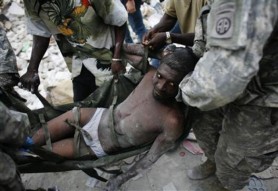The 35-year-old man, covered in dust and dressed only in underpants, was carried from the ruins of a building in downtown Port-au-Prince on a stretcher and driven off for medical treatment.
He was rescued by soldiers of the 82nd Airborne Division, and did not appear to have any serious injuries.
More than 130 people have been pulled out still living from under wrecked buildings by rescue teams from around the world, although hopes of finding more survivors are fading fast.
The latest rescue, exactly 14 days after the magnitude-7.0 earthquake killed as many as 200,000 people, came as the U.S.-led relief effort was focused on getting help to hundreds of thousands of survivors left homeless, hungry and injured.
Brazilian U.N. peacekeeping troops sprayed tear gas at a frenzied crowd of thousands crowding a food handout outside the wrecked presidential palace earlier yesterday.
“They’re not violent, just desperate. They just want to eat,” Brazilian Army Colonel Fernando Soares said. “The problem is, there is not enough food for everyone.”
U.S. troops, U.N. peacekeepers and aid workers have widened and intensified the distribution of food and water, but many Haitians are still not receiving emergency aid.
Some of the food handouts in the capital have turned unruly, although the United Nations said the overall security situation in Port-au-Prince remained stable and that about two-thirds of Haiti’s police force has returned to work.

At the presidential palace yesterday, U.N. troops with shotguns protected relief workers handing out sacks of rice with American flags on them. Armored trucks formed a cordon to control the crowd and people were searched as they entered the checkpoint.
“Yesterday they gave us rice, but there was not enough. There were too many people,” said Wola Levolise, 47, who is living in the camp with her nine children.
The U.N. World Food Program said it handed out 60 tons of food at the camp but ended the distribution early when the crowd got out of control.
“There are isolated, regrettable incidents but these are the exceptions and not the rule,” a WFP spokesman said.
The U.N. agency said it has delivered nearly 10 million meals to almost 450,000 people since the quake.
Unsanitary living conditions in Port-au-Prince have raised fears of an outbreak of disease.
So far, doctors on the U.S. Navy hospital ship Comfort, anchored offshore, said they had one case each of typhoid and tuberculosis and several of tetanus, malaria and dysentery.
Lewis Lucke, the retired U.S. ambassador coordinating the relief effort, said aid was moving as fast as possible given the chaotic conditions. “This is really a disaster of biblical proportions,” he told Reuters.
JOBS PROGRAM
In a bid to get the economy going, the United Nations is offering 150 gourdes ($3.77) a day plus food rations to those willing to take jobs clearing rubble from roads and removing waste that posed a potential health threat.
More than 5,500 Haitians had already started the two-week jobs, using shovels, hammers, wheelbarrows and trucks to load debris and haul it to landfills.
The U.S. military said it could scale back its involvement within three to six months as other international organizations assume larger roles providing security and disaster relief. It does, however, plan to help build a 5,000-bed hospital to provide longer-term care to quake victims.
The United States has dispatched more than 15,000 military personnel to Haiti; about 4,700 are deployed on the ground.
There were signs the ruined capital was slowly returning to life. A city garbage truck hauled away piles of rubbish at a makeshift camp and a long line snaked outside a bank in the suburb of Petionville. A street market along Rue Geffrard in Port-au-Prince was crowded and chaotic.
The capital’s destroyed downtown commercial area, however, had few open shops. Scavengers picked at smashed buildings for planks of lumber, steel bars and other building materials.
The Haitian government says about 1 million Haitians weredisplaced from their homes in the capital. It had tents for 400,000 to be used in temporary tent villages to be built outside the city, but said 200,000 more would be needed.
Tents are especially important with the approach of the rainy season, which begins in April.
The United Nations said the exodus of quake victims out of the capital has slowed to a trickle, with less than 1,000 leaving over the past day. About 236,000 people have left for the countryside but the United Nations said most had moved in with relatives and large-scale shelter wouldn’t be needed.





